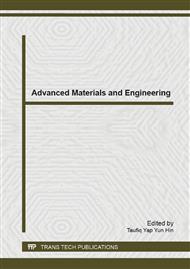p.84
p.90
p.94
p.99
p.105
p.110
p.116
p.121
p.127
Effect of Injection Conditions on the Electrical Conductivity of MWCNTs/PC Conductive Composites
Abstract:
Multiwalled carbon nanotubes/Polycarbonate (MWCNTs/PC) nanocomposites were successfully prepared by melting mixing. With the injection speed and temperature changed, different MWCNTs contents MWCNTs/ PC composites were prepared. The electrical conductivity of nanocomposites was compared with different injection speeds and injection temperatures. It was found that the electrical conductivity of the MWCNTs/PC nanocomposites was decreased with MWNTs content increasing, and were both affected by the injection speed and temperature. Besides, at the vicinity of the surface of samples, the resistivity of MWCNTs/PC nanocomposites was the maximum; the closer to the samples inner, the resistivity was smaller and more stabilized. The microstructure and morphology of composites were analyzed by Scanning Electron Microscopy (SEM) techniques, and the MWCNTs’ dispersion in PC matrix and the interfacial interaction between MWCNTs and PC were analyzed.
Info:
Periodical:
Pages:
105-109
Citation:
Online since:
June 2014
Authors:
Price:
Сopyright:
© 2014 Trans Tech Publications Ltd. All Rights Reserved
Share:
Citation:


